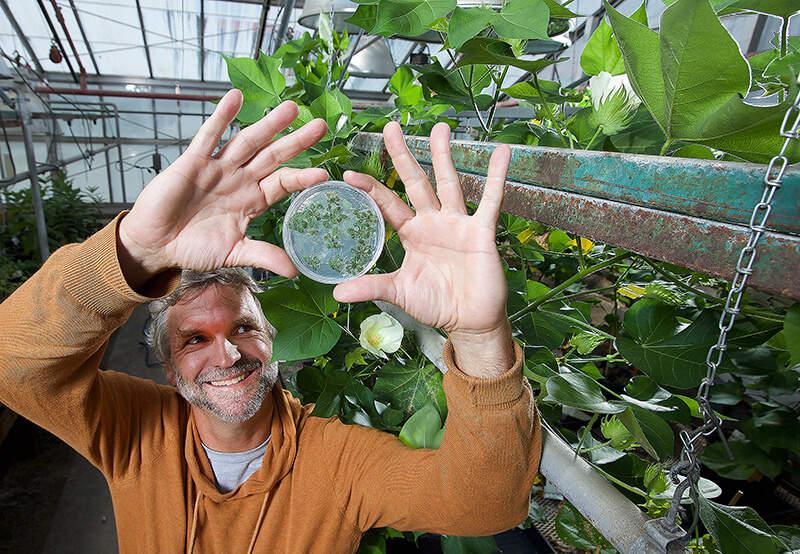July 19, 2018
Study finds key to plant growth control mechanism
 Daniel Szymanski used the model plant Arabidopsis (in his hand) to map the complex pathways that control plant cell shape. The findings may be key to improving the quality of cotton (in the background) grown in the United States. (Purdue Ag Communication photo/Tom Campbell)
Download image
Daniel Szymanski used the model plant Arabidopsis (in his hand) to map the complex pathways that control plant cell shape. The findings may be key to improving the quality of cotton (in the background) grown in the United States. (Purdue Ag Communication photo/Tom Campbell)
Download image
WEST LAFAYETTE, Ind. – A Purdue University study has mapped a complex series of pathways that control the shape of plant cells. The findings are an important step toward customizing how plants grow to suit particular agronomic needs and improving the quality of the cotton grown in the United States.
Cotton production is a $25 billion industry in the United States, but the types of cotton farmers can grow here is of lesser quality than premium Egyptian or Pima cottons, which have smaller fiber diameters. Daniel Szymanski, professor in the Department of Botany and Plant Pathology, analyzed how intracellular signaling networks pattern cell walls to generate particular cell shapes and sizes. This knowledge from the Arabidopsis model system can be used to generate cotton fiber cells with smaller diameter or increased strength.
In findings published in the journal Current Biology, Szymanski described how microtubules and actin, protein polymers that form the cytoskeletons of plant cells, are organized to specify the mechanical properties of cell walls that define cell shape.
Szymanski’s group found that microtubules entrap a protein called SPIKE 1 within the apex of a cell where SPIKE 1 recruits additional protein machineries that cause actin filaments to form. Actin filament networks are then organized as roadways for long-distance intracellular transport and the regulated delivery of cell wall materials that are necessary for cell growth.
“SPIKE 1 is a master regulator in cells, a switch that when activated determines the time and location where actin networks are polymerized,” Szymanski said.
The location and activity of SPIKE1 is important. Without it, growth is misregulated, leading to distorted cell shapes that do not taper properly. The SPIKE1 protein is one of a growing number of tools that could be used to program the size and shapes of economically important cells, including cotton fibers.
Szymanski said this new understanding will also likely play a broader role in designing plants that have different cell shapes and sizes.
“Cells are building blocks for tissues and organs, and they have the potential to influence key traits like leaf size,” Szymanski said. “This work provides a knowledge base that will enable cell, tissue and organ engineering.”
A National Science Foundation Molecular and Cellular Biosciences Grant supported this research.
Writer: Brian Wallheimer, 765-532-0233, bwallhei@purdue.edu
Source: Daniel Szymanski, 765-494-8092, dszyman@purdue.edu
ABSTRACT
Microtubule-dependent confinement of a cell signaling and actin polymerization control module regulates polarized cell growth
Makoto Yanagisawa1,4, Jose M. Alonso3 and Daniel B. Szymanski1,2,
- Departments of Botany and Plant Pathology, Purdue University, West Lafayette, IN
- Department of Biological Sciences, Purdue University, West Lafayette, IN
- Department of Plant & Microbial Biology, North Carolina State University, Raleigh, NC
- Present address: Departments of Botany and Laboratory of Cell & Molecular Biology, University of Wisconsin-Madison, Madison, WI
Different cell types use many of the same signaling and cytoskeletal proteins to pattern the geometry of cell shape change. However, the mechanisms by which the cytoskeleton is patterned at the spatial and temporal scales that dictate cell morphology are not known. Here, we used combinations of live cell imaging probes and unique genetic resources in Arabidopsis to discover how the microtubule and actin systems are spatially coordinated to pattern polarized growth in leaf epidermal cells. The DOCK-family guanine nucleotide exchange factor (GEF) SPIKE1 clusters and activates the conserved heteromeric WAVE/SCAR and ARP2/3 complexes at the cell apex to generate organized actin networks that define general cytoplasmic flow patterns. Cortical microtubules corral punctate SPIKE1 signaling nodules and restrict actin polymerization within a broad microtubule-depletion zone at the cell apex. Our data provide a useful model for cell shape control, in which a GEF, actin filament nucleation complexes, microtubules, and the cell wall function as interacting systems that dynamically pattern polarized growth.
Agricultural Communications: (765) 494-8403;
Maureen Manier, Department Head, mmanier@purdue.edu

